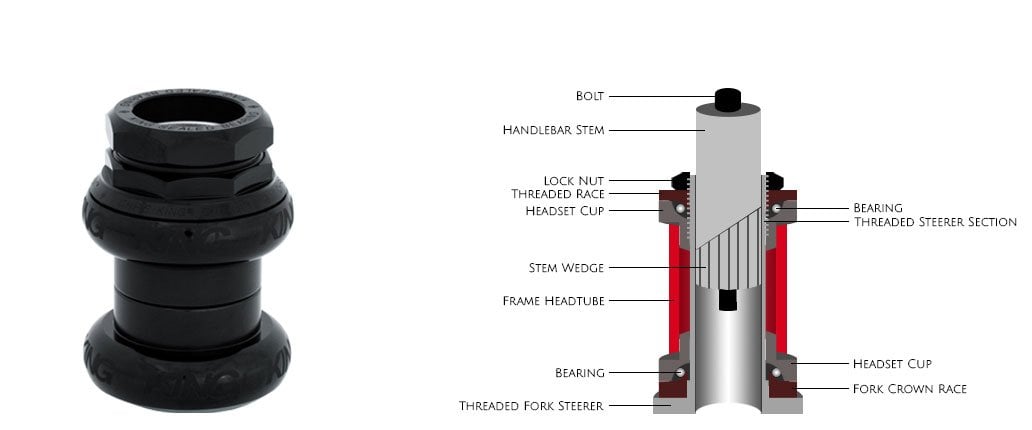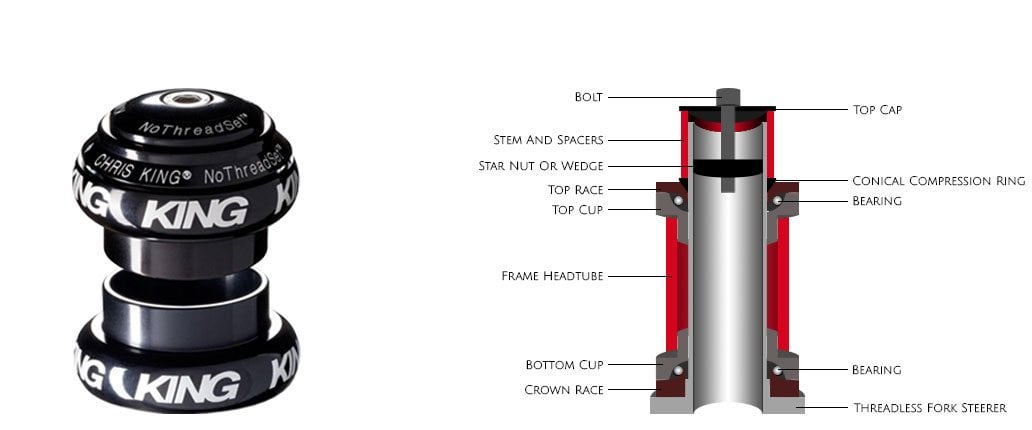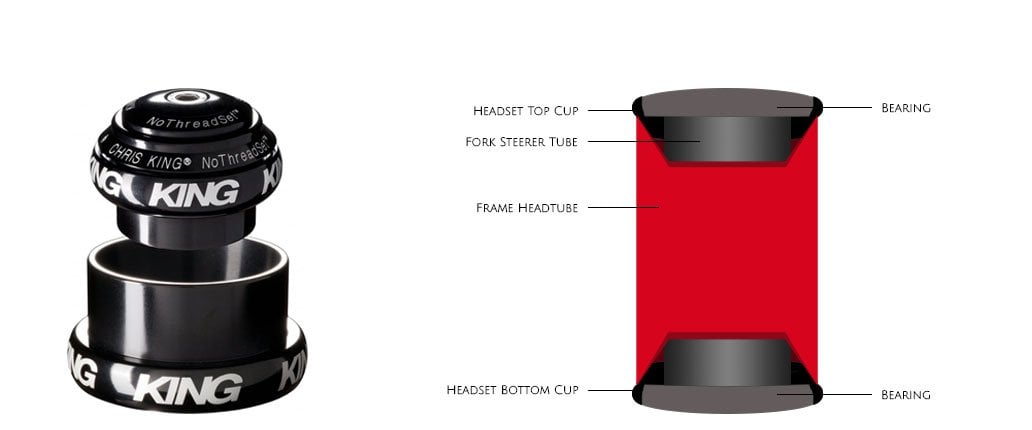
Bike Headset Guide
Welcome to Westbrook Cycles' bicycle headset guide. With so many different types of bike headset available, we realise it can be tricky to find the correct one for your bike.
What is a bike headset? Is there a difference between a road bike headset and a mountain bike headset? What's the difference between an Integrated headset and a Semi Integrated headset? A lot of these terms can seem like complicated jargon if you are not familiar with them, so we've written this guide to the various different headset types in a hope that you will be able to find exactly what you're looking for. See below for an explanation of each of the various headset types and if anything is still unclear, then please get in touch with us and we'll try our best to help you out.
What is a bike headset?
Simply put, a headset is two bearings at either end of your bike frame's headtube which the forks pass through. These bearings allow the forks to turn inside the frame, without wobbling around or moving forwards and backwards. The headset usually also comprises of a method of holding these two bearings securely in place, and have various other components such as seals to keep dirt and moisture out of the bearings. Modern "threadless" or "aheadset" designs will usually also have some method of applying preload to the system before the handlebar stem is tightened on to the fork's steerer tube. This ensures that once the handlebar stem bolts have been tightened, the system will not be loose and sloppy which could result in damage to the bearings or even the frame and forks. Below details the difference between the individual designs.
Threaded Headset
These headsets, sometimes referred to as a 1 inch bike headset as this was the most common fork steerer tube diameter, have been superseded on most bikes now but are still found on some budget bikes and retro & classic bikes. At one point the threaded headset was the standard headset for all bicycles, but they are much less common now.
The threaded headset is so-called because the steerer tube on the forks has a thread on it, which a locking nut would tighten down on and keep the headset compressed together. The headset bearings are usually unsealed which can lead to dirt entering the bearings and cause them to wear out earlier.
The handlebar stem, in this case known as a quill stem, then attaches to the fork by sliding inside of the fork's steerer tube and utilising an expanding wedge at the bottom of the stem, tightened by a bolt at the top. This design allows for the stem height to be adjust easily and without any other components such as stem stackers/spacers, but it is more prone to slipping around in a crash. Another drawback to this design is that the fork steerer must match the steerer tube length on the bike, whereas a threadless design allows for the steerer tube to be left longer allowing the forks to be swapped between frames more easily.
Probably the most significant drawback to this design is that they have a tendency to come loose, particularly on mountain bike headsets, which causes the whole front end to go wobbly and can damage the headset.

Threadless Headset (Sometimes known as Aheadset)
Most bikes now use some variation on the "Threadless Headset" design. There are a few different versions of threadless headsets, but generally they all have the same basic principle. They comprise of a bearing, often sealed, at either end of the headtube and rely on a simple pre-load system to ensure the components fit together correctly without any play. Once the system is preloaded, the bolts on the handlebar stem can be tightened, clamping the stem directly onto the fork steerer and keeping the whole system together.
The preload system itself can vary slightly, from using a star-shaped nut (sometimes referred to as a star fangled nut), to some sort of bung or compression wedge, such as the Hope Head Doctor. Regardless which design is used, the outcome is the same; the nut or wedge grips the internal sides of the fork steerer and as the central bolt is tightened, the system is pulled together to eliminate any play. Depending on the material of the fork steerer tube, there may be limitations on which design can be used as it is not recommended a star nut is used on steerer tubes made from carbon fibre. It is also recommended that a small gap is left between the top of the fork steerer tube and the top of the stem or top spacer so that the system can be properly preloaded. Please pay attention to your handlebar stem manufacturer's instructions as some require a spacer above the stem for safety purposes and not having one in place may invalidate your warranty. Below are some of the different variants on Threadless Headsets.


External Bearing Threadless Headset
This is the original design for the Threadless Headset and involves having the bike headset bearings seated in cups outside the headtube of the frame. Although some manufacturers such as Chris King require the bearings to be pressed into the headset cups, most designs just require a reasonably snug fit with the bearings which can be placed in without any tools. The latter of these designs usually means that once the headset cups have been fitted, they don't need to be removed to replace the bearings. The bearings themselves can be easily removed and replaced, with the remaining bike headset parts just requiring cleaning and regreasing.

Semi Integrated Headset
What is Semi Integrated headset? Semi Integrated headset bearings sit in cups that are separate from the frame's headtube as in the previous design described above, however the cups sit inside the headtube instead of protruding externally. The bearing cups often feature a small lip that stops the cup from being pressed completely into the frame's headtube, but the bearings are seated completely within the headtube. Usually to allow this design to be used, the headtube must be larger than some more traditional frames. This can lead to a more aesthetically pleasing design which helps to keep the bearings out of more dirt and grime, and can mean that the headtube is stiffer due to having more material connecting it to the frame. As with the external bearing headset, there usually isn't a need to press the bearings into the cups as a conical seat is usually used, causing the bearings to self align once preload is applied.

Integrated Headset
The integrated headset is almost identical to the semi-integrated headset in its design, but arguably simplifies the system even further by doing away with the need for separate bearing cups. The up-sides to this include getting a much cleaner look where the frame's headtube joins the forks, along with making maintenance a little easier for the home mechanic as only the top and bottom bearings require changing once they have reached the end of their lives. Dirt and grime cannot enter the moving bearings as easily in this system, meaning longevity is increased and some manufacturers favour the design for their more aero-orientated frames due to the sleek profile it presents. Again, bearing alignment is achieved through a conical seating interface which auto aligns the bearing once preloaded.
The most modern design to date is the integrated tapered headset which is based on a fork steerer tube that is wider at the bottom than it is at the top, meaning the bottom headset bearing, and cup if relevant, is larger in diameter than the top bearing and cup.

It is quite common for some manufacturers to mix some of these headset designs, using setups such as a semi integrated top bearing with an external lower headset bearing. This can be for a number of reasons ranging from varying manufacturing costs, to allowing the rider to use different wheel sizes whilst maintaining a certain head angle. Some component manufacturers will offer completely separate top and bottom headset options to be purchased, such as the Pick And Mix headset from Hope Technology.

What Is A Crown Race?
Originally the crown race was a metal disc that fit very snugly around the fork's steerer tube and on top of the fork's crown to provide the loose ball bearings with a smooth surface to roll on. With sealed cartridge bearings that are found in most modern headsets, the crown race is now just a surface for the bottom headset bearing to sit on. It is still important to get the correct race for your headset however, as a lot of them only fit specific bearings. If you completely change the headset on your bike at any point then you may find that you need to replace the crown race as well.
In some cases, more commonly with road bike headset bearings, the crown race is integrated into the fork crown itself eliminating the need for a separate race. These are usually machined to either a 36 degree or a 45 degree angle, which the headset bearing will need to match to correctly seat.
What Is A Tapered Headset?
A tapered headset is where the bottom bearing in the system is of a larger diameter than the top bearing, with the fork's steerer tube being of a similar wide-at-the-bottom and narrow-at-the-top profile. This design is implemented by manufacturers for a few reasons, but the main aim is to provide more strength and durability at the base of the steerer tube, while reducing weight at the top of the headtube. A lot of modern mountain bike headset bearings are of a much larger diameter than the 1 inch steerers utilised on older models, with 1.5" steerer tubes being common on Enduro or All Mountain bikes. Road bikes similarly adopt this tapered steerer tube approach, with the larger bottom bearing allowing manufacturers to build strength and stiffness into the base of the headtube, whilst the smaller top bearing allows frame designers to save weight where the top tube meets the headtube.
What Do The Letters And Numbers Mean In Headset Names?
You may have noticed that a lot of headsets have some letters and number in their name, such as IS52/31.8 - IS52/40. So what does it all mean? These are what is known as the SHIS code, or Standardised Headset Identification System. The letters simply tell you what type of headset it is:
- EC - External Cup (Bearing cups are outside the headset of the frame)
- ZS - Zero Stack or Semi Integrated (Bearings are inside the headtube of the frame, but in separate cups that can be removed)
- IS - Integrated (Bearings sit directly into cups that are built into the frame's headtube)
The numbers refer to the size of the headset, which is measured in millimeters and is usually a very precise tolerance so if you are not sure what size you require, some Vernier Callipers should be used to take an accurate measurement. Once you have your measurements and you know what kind of headset you require, you just need to match it to the relevant table below to find your SHIS code, which should make purchasing a replacement or upgrade a bit easier.
EC External Cup Headset SHIS
SHIS Name | Bore Inside Diameter (mm) | Cup Outside Diameter (mm) |
EC29 | 29.85 - 29.9 | 30 - 30.1 |
EC30 | 30.05 - 30.1 | 30.2 - 30.3 |
EC33 | 32.6 - 32.7 | 32.8 - 32.9 |
EC34 | 33.9 - 33.95 | 34.05 - 34.15 |
EC37 | 36.9 - 36.95 | 37.05 - 37.15 |
EC44 | 43.95 - 44 | 44.1 - 44.15 |
EC49 | 49.57 - 49.61 | 49.7 - 49.75 |
EC56 | 55.9 - 55.95 | 56 - 56.05 |
The bore depth on EC headsets should be a minimum of 15mm.
ZS Zero Stack/Semi Integrated Headset SHIS
SHIS Name | Bore Inside Diameter (mm) | Cup Outside Diameter (mm) |
ZS41 | 41.35 - 41.4 | 41.45 - 41.5 |
ZS44 | 43.95 - 44 | 44.05 - 44.1 |
ZS49 | 49.57 - 49.61 | 49.7 - 49.75 |
ZS55 | 54.9 - 54.95 | 55.05 - 55.1 |
ZS56 | 55.9 - 55.95 | 56.05 - 56.1 |
The bore depth on ZS headsets should be a minimum of 12.5mm.
IS Integrated Headset SHIS
SHIS Name | Bore Inside Diameter (mm) | Cup Outside Diameter (mm) | Bore Depth (mm) |
IS38 | 28.15 - 38.25 | 38 | 3.1 - 3.2 (top) / 6.9 - 7 (base) |
IS41 | 41.1 - 41.2 | 41 | 3.1 - 3.2 (top) / 6.9 - 7 (base) |
IS42 | 41.95 - 42.05 | 41.8 | 2.8 - 3.0 (top) / 6.6 - 6.8 (base) |
IS47 | 47 - 47.1 | 47 | 49.1 - 49.2 (base) |
IS49 | 49.10 - 49.2 | 49 | 51.1 - 51.15 (base) |
IS52 | 52.05 - 52.15 | 52 | 7.3 - 7.5 (base) |
All SHIS references for IS headsets are for a 45 degree contact angle with the frame's headtube as 36 degrees is now considered obsolete.
Along with these dimensions, the headset is identified by the diameter of the fork's steerer tube at either end of the bike's headtube. The upper steerer diameter measurement is simply the diameter in millimeters of the steerer tube, along with the thead for older, threaded steerer tubes. The lower measurement is based around the fork crown race diameter, again in millimeters.
Fork Steerer SHIS
Common Name | SHIS Name | Fork Steerer Diameter (mm) |
1" Threaded (French) | M25-1.0 | 25 |
1" Threaded | 25.4-24tpi | 25.4 |
1-1/8" Threaded | 28.6-26tpi | 28.6 |
1-1/4" Threaded | 31.8-26tpi | 31.8 |
1" Threadless | 25.4 | 25.4 |
1-1/8" Threadless | 28.6 | 28.6 |
1-1/4" Threadless | 31.8 | 31.8 |
1-1/2" Threadless | 38.1 | 38.1 |
Crown Race SHIS
Common Name | SHIS Name | Crown Race Diameter (mm) |
1" Pro | 26 | 26.43 - 26.49 |
1" JIS | 27 | 27.03 - 27.09 |
1-1/8" | 30 | 30.015 - 30.075 |
1-1/4" | 33 | 33.03 - 33.09 |
1.5" | 40 | 39.79 - 39.85 |
Putting all of this information together gives us our SHIS headset identification number. For example, a fork with a straight (not tapered) steerer tube with a diameter of 1-1/8" in a traditional frame that uses external bearing cups would be EC34/28.6 - EC34/30.

We're Here To Help
Although we've tried our best to explain the differences, we know there will always be an exception to the rules and we appreciate that not everyone has a set of Vernier Callipers in their bike tool kit. If you need any help with understanding or finding the correct headset for your bike, or for any other bike related matters, please get in touch by calling us on (+44)1642 710232 or via our online contact form, here.